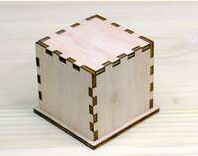The retro looks of Nixie tubes sure is something that many people can appreciate including myself. Browsing the internet you’ll find several popular usages of these ancient electronic relics such as clocks thermometers, VA-meters and more. The tubes itself are not always literally ancient though, they’re still build and sold brand new so when you start looking around you should still be able to grab a few for your own. But I’ll warn you: the do not come cheap!
Enter the Electro Nixie clock! Elector has been offering a kit where you can build your own Nixie clock yourselves. Given that those tubes take a high voltage I thought it would not be a bad idea to try the kit instead of doing the full electronics design and such myself. It comes with a members discount plus I got special discount which made the price more acceptable. Elector also designed a housing for it to give it that extra spark as you can see below. I went for the Elector deal but didn’t go for the acrylic housing because I wasn’t particularly found on that. So now I have to come up with something of my own… For that I take you on this little trip that shows you how ‘easily’ it is nowadays to come up with something that even your wife may appreciate!

So I started drawing…

I gave it a first try crafting all of that by hand but the end result looked really ridiculous: the wife didn’t agree! With the right tools this is going to be so much better. Then I remembered there is nowadays a python plugin that can generate a complete drawing of a box for you so that you don’t need to worry about all the details anymore. And guess what: someone made a website for that! Boxes.py is the place to be.
I went for the BasedBox design, here are my settings:

But I wanted to add a little detail myself, I wanted to have a black front. Luckily the generated files from boxes.py are in the svg format which can easily be edited on linux using with Inkscape. An hour later (I’m not a very skilled Inkscape user) I got to my final drawing:

For the front plate I came up with following design:

Next step was getting it produced using laser cutting techniques. The guys at Snijlab.nl allow you easily upload your drawing in all sorts of formats. They have a wide range of materials that you can choice from, the website works really well and by the end of the route you get a final offer so that you don’t get any surprises when you order your stuff. Few days later the goods arrived at home and we could start assembling thins…

First I had to drill some holes in the bottom and back so that I could fix the PCB, power supply connector and user switch.

To fix the front plate without visual screws I also had to cut an aluminum plate on which we can glue the front plate:

And then comes the final stage: putting the box together:


I hope you like the end result, and I hope this inspires you to get building yourself. Good luck!

